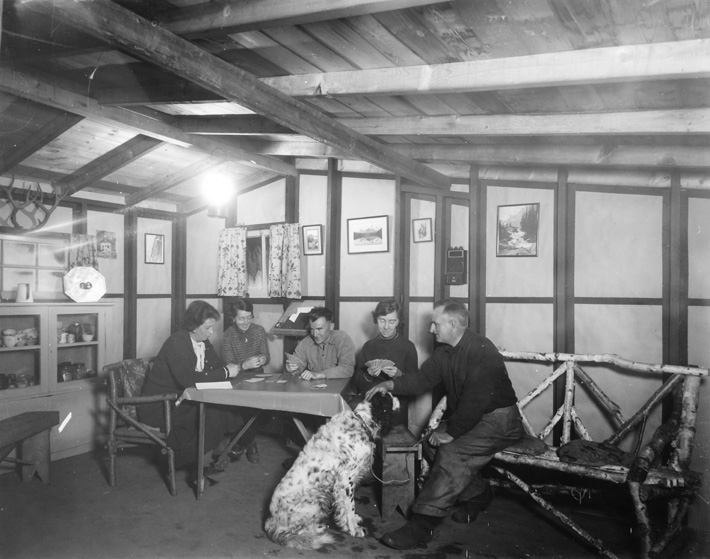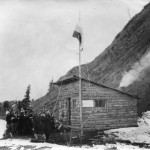Edmonton’s first alpine hut—The Eyrie—opened February 26, 1928. High on Quesnell Heights it looked out on a mighty river. Friends and dignitaries cheered the Edmonton Section of the Alpine Club of Canada, as they crowded inside to eat. A blazing fire and sing along featured a rhapsody to Edmonton’s mountaineers and tramping in Laurier Park. Clad in rough spruce, the hut was built “on a bluff overlooking the Saskatchewan about three miles west of the City, and every weekend saw a number of members hard at work with saw and hammer. ” The “semi-tropical weather” impeded the hut’s first winter snowshoe ventures, but mountaineers made many a rendezvous by snowshoe, ski, and “Shank pony” to get there, until it was destroyed by vandalism.
Starting over, a new hut was tucked west of Whitemud Creek at Fox Farm. A Burgess Shale trilobite accented its handcrafted fireplace. Whitemud Creek Hut opened November 27, 1932, with guests from the Voyageur Canoe Club’s nearby cabin. “Tales of climbing the high ridges, and of canoeists combating the rapids of the Saskatchewan river, together with Alpine and Canadian boat songs passed the evening all too quickly.” They loved high adventure in the great outdoors, even if was near home or embellished to tell a better tale. Winter sport trends grew in 1936 as the Hut tripled in size with an addition and “rustic veranda” for more après ski cocktails. It was known in later years as “Terwillegar Hut” after Dr. Terwillegar who leased the land; he’s better known today, thanks to urban sprawl that ate valuable farmland.
Whitemud Creek Ravine was a perfect country getaway, far from Whyte Avenue’s madding crowds. Weekend hikes and the occasional log rafting jaunt were followed by tea at the hut. Edmonton’s ACC Section played up skiing and winter sports on its north face slopes. Spring “Skigatta” competitions tested the elevation with slalom, relay and novelty races in the 1930s.
Christmas parties with ski runs, creek skating, and fireside communal suppers attracted even Santa Claus himself. Visiting mountaineers, as well as other ski clubs, were well entertained. Ella May Walker—Edmonton heritage diva, painter and concert pianist—was reputed to shred the accordion at many a campfire and sing along among mountaineering pals.
Crossing Quesnell Bridge has new meaning knowing its riverbanks were home to intrepid mountaineering adventures and alpine huts. And, yeah, they did it all over again in Jasper.
© PearlAnn Reichwein, 2014



